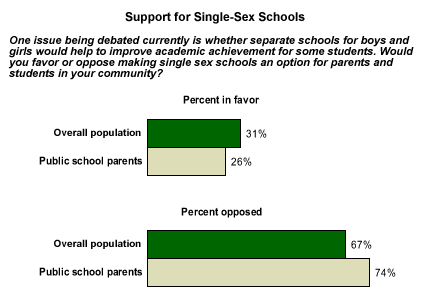Though they're perfectly legal, we don't see many single-sex public schools in the United States (there are only 15) because it's difficult for most districts to provide identical, separate facilities for both sexes. And frankly, Americans haven't much cared about the issue. So it may come as a surprise to learn that the No Child Left Behind Act, the sweeping education legislation enacted in January, authorizes education agencies to use funds provided by the act to establish public same-gender schools and classrooms.
In a May release, U.S. Education Department Secretary Rod Paige "invites comments on whether and under what circumstances the use of single-sex classes should be permitted under the Title IX regulations." Gallup Poll results provide insights on what Americans are likely to say.
Gender Blender
Apparently, most Americans don't find single-sex education all that appealing. The 2002 Phi Delta Kappa/Gallup Poll of the Public's Attitudes Toward the Public Schools* found that 67% of the public opposes "making single-sex schools an option" in their communities. Only 31% support it.

The adults with the most invested in the public schools -- public school parents -- are the least fond of single-sex education. Seventy-four percent don't want it as an option in their communities. Those who don't have kids in school are a bit more amenable, but certainly not supportive. Sixty-five percent oppose the idea of a local single-sex school. Women are about as likely as men to oppose it -- 65% to 68%, respectively -- even though girls are thought to be the greatest beneficiaries of such a system.
Boy Meets Girl, Then What?
The theory put forth by proponents of same-sex education is that boys and girls learn differently, distract each other, and foment unintended sexism from their teachers. For instance, the gender gap in math and science has been blamed on girls' hesitation to compete with boys. Dr. James Lewis, the chair of the mathematics and statistics department at the University of Nebraska-Lincoln (UNL), said, "The young women in my classes have issues related to confidence in math, their reasoning ability, an absence of [female] role models."
Some research suggests single-sex schools better educate their pupils. Studies released last year in England and Australia study found that students in single-sex schools had better grades on average. However, although we're told males and females are "hard wired" to learn differently, neurological research into sex-related learning differences hasn't proven it to the degree that would mandate single-sex schools. Dr. Richard Dienstbier, a UNL psychology professor said, "There really isn't that much difference in the brains of the average male and the average female. Intellectual differences don't necessitate single-sex schools, but the way society responds may." Some critics maintain that single-sex public schools, by the nature of their missions, have small class sizes and attract unusually committed and talented teachers -- and that's what accounts for the higher grades. Other educators wonder how boys and girls will cope in the working world if they don't socialize, compete and collaborate with members of the opposite sex in school.
Key Points
As soon they get the nod from the government, and the promised cash, some districts will begin to institute single-sex public schools. And maybe it will work. On the other hand, maybe it isn't the students who will change. According to Dienstbier, "We really don't know much about [neurological] learning, there's been very little research. But, if people keep insisting that males are better than females at things like math, girls may excel in single-sex classes."
*These results are based on telephone interviews with a randomly selected national sample of 1,000 adults, aged 18 and older, conducted June 5-26, 2002. For results based on this sample, one can say with 95% confidence that the maximum error attributable to sampling and other random effects is ±3%. In addition to sampling error, question wording and practical difficulties in conducting surveys can introduce error or bias into the findings of public opinion polls.